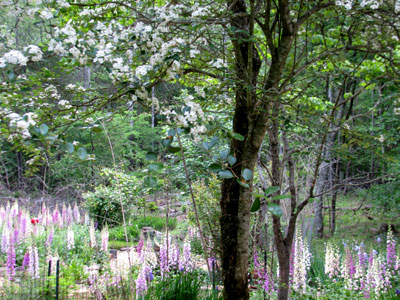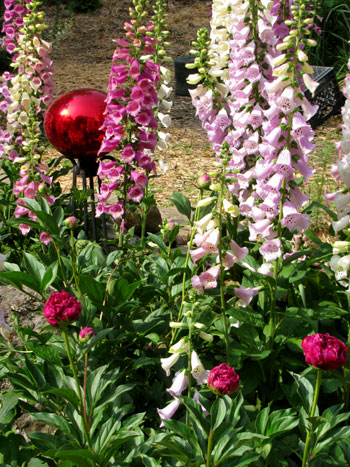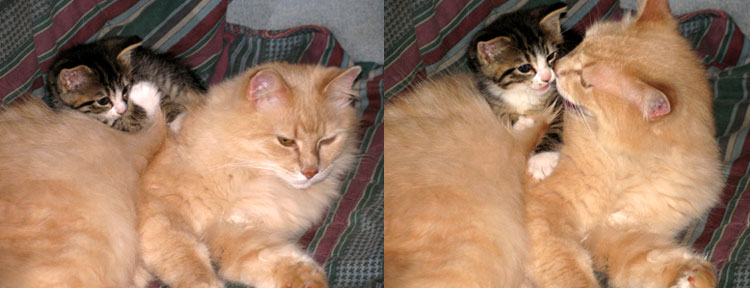
Hawthorn trees are thick with thorns year round and lush with flowers in spring.

Hawthorn trees are thick with thorns year round and lush with flowers in spring.
A garden is a web of life: mineral, animal and plant life.
We gardeners orchestrate much of what appears in the garden. But Mother Nature is the true spinner of the web of life in our gardens. I am drawn to a garden with personality and unexpected quirks. I am drawn to gardens emphasizing the collaboration with Nature. Our gardens have appeared slowly over the last twenty-five years. Nature has presented unexpected treasures like the tree along our front entrance with the large thorns marching up its trunk and spaced down the limbs. The deer would not dare browse this formidable forest citizen. But, a wild grape vine with a five-inch trunk had engulfed the canopy of this unidentified variety of hawthorn almost killing it. Once we cut back the grape and removed some large sweet gum trees that kept the hawthorn in shade, we discovered this lovely spring bloomer. Four years later our sturdy hawthorn has grown taller and greets the sunny days of spring covered in delicate white blossoms as it arches over the walkway. In fall the red/orange berries provide food for the birds preparing for winter. In this case, all we did was remove the other plants stealing the sunshine on the hawthorn–we just got out of the way!

In the orchid family, but Yellow Ladyslipper flowers bloom in our Ozark hardwood forest.
Providing a shady spot for the native yellow ladyslipper orchid was a different challenge. Over a decade ago we discovered a small colony of these showy yellow wildflowers
in the moist woods beyond our house. Each spring we looked forward to viewing their spectacular curved blooms. Then came the spring where the deer mowed the entire colony to the ground causing us to fence that three foot area and hope the plant would recover. It was several years before the ladyslippers recovered and bloomed in their protected enclosure. Five years ago I noticed that a single stem of new growth had grown beyond the fence. I carefully transplanted that shoot because I knew how fragile was the existence of the colony given the deer population. By that time, I knew I could provide a spot for it in my Rusty, Rustic shade garden. You can see the picture of this plant thriving next to a lush maidenhair fern. Ladyslippers are in the orchid family—our Orchid Creek was named by our neighbor Sharman Sturchio in honor of these lovely native orchids. In this case we actively assisted nature by providing a protective enclosure for the ladyslippers.

Here the Ladyslipper is thriving next to a lush maidenhair fern.
Years ago I heard an interview with southern writer and avid gardener Bailey White on NPR as she recounted how gardens had been an important asset in binding a community together. In the South, in the days before big box garden centers, gardeners swapped plants and gave starts to each other of plants that thrived in the locale. “Pass-alongs” were a tradition connecting gardeners with a passion for growing as many plants as possible. She explained that if you wanted a start of a particular rose or a lush hydrangea in south Georgia in those days, you made sure you were in good standing with the gardener who grew those plants. Gardens were nurtured by gardeners who shared extra plants. Seeds, seedlings, slips and starts, cuttings and divisions from one gardener enriched the life of anyone receiving these pass-alongs. Often the shared plants came with stories of their origins. Always the plants came with accurate information about preferred growing conditions. And you knew the plant was well adapted to your area!
Seven hundred hostas later I can speak of the value to my garden of a dark green hosta given to me by my long time friend, Martha Payne. Eighteen years ago Martha gave me three hostas belonging to her mother after her mother’s death. Once the lovely white flower stalks mature they drop hundreds of seeds teaching me the meaning of the phrase “prolific self seeder”. Often times that phrase is issued as a warning when one receives a pass-along plant to warn you of the possibilities of many more seedlings. In this case Martha’s hostas from Kansas City, KS have thrived here and given a lush richness to my shade garden and to the shady sections of our back yard. I pot up hundreds of seedlings and pass them to neighbors and friends. If you want some of these hosta seeds, send me a self-addresses, stamped envelope and I will pass hosta seeds along to you.

Fran's red gazing ball reminds us both of Jeanne's mom.
Our red gazing ball is a new addition to our garden. Jeanne gave it as a gift to her mother a number of years ago. Fran enjoyed seeing it in her yard for many years before her death at 94 last July. Her gazing ball compliments our blooming peonies. We want to update you on our ceiling project–we’re two-thirds finished.It has been slow-going due to Kas’ schedule and our own schedules. It looks good and we look forward to removing the scaffolding from our living space.
The other news is that our kitten, Catfish, and Scout have bonded! Catfish is full of energy and enjoys following Scout to pounce on him whenever possible. They often sleep together like good buddies. Catfish is now eight weeks old. We feel we have been successful in providing a new feline companion for Scout after loosing both Summer and Striper. All four dogs have accepted him and Zora enjoys playing with him at times she chooses.

Catfish and Scout--feline companions.


Just wanted to clarify that we cut down the sweetgums in front of our house because they had gotten so tall that they were blocking the sun from the solar panels. Those sweetgums grow incredibly fast!
Comment by Jeanne Neath — May 10, 2012 @ 3:49 am
Looks like new kitty pals are doing fine. Soooo cute!!!
Comment by Martha — May 12, 2012 @ 11:37 am